





Time for a look at an interesting range of products with great potential for gardeners
You can't have too many pots or containers but unfortunately, they are not cheap. This is especially true about display pots, which can be hard to keep up to demand. For this reason, it is a good idea to get as much as we can out of the pots we have & refurbishing them is one way of doing it.
In her article "Make-over Your Old Flowerpots: A Face-lift For Weathered Plastic", Melody Rose showed how to revitalise old plastic pots using oil paints. This is a great idea because it not only provides attractive results, but also affords some measure of U-V protection. If one factor leads to the demise of plastic pots more than all others, it is brittleness caused by prolonged sun exposure.
This article is going to look at a slightly different way of refurbishing plastic pots & other kinds of containers, using a material that may be employed to similar effect in other ways. Liquid stone is a weatherproof, paint-like finish meant for more than just touching up pots. This product is available in a range of styles & can be applied to concrete, metalwork & most other surfaces; helping to build a consistent look throughout gardens & outdoor areas. Perhaps you'd like a terracotta wall to extend a mediterranean theme, or an instant sandstone patio under your planters. Liquid stone makes these kinds of things quite possible.
Mega Treat 2000 is a small but excellent range of outdoor finishes produced in Australia. Mega Treat lends the appearance & texture of clay or stone, but is suitable for most building surfaces. There are Liquid Teracotta, Sandstone & Limestone styles available, representing the possibility of natural & medditerranean themes. They are waterbased, tintable, non-toxic & fungus resistant. Plus, a sealant is available that will hardened these finishes against foot traffic.
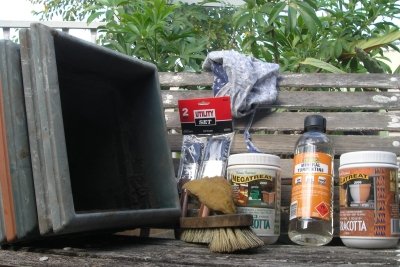
Having been curious about liquid stone for some time, I recently decided to test it out. I found Mega Treat readily available in standard single litre jars. These retail for approximately AU$25.00, which is about the same as chalkboard paint. That is, not cheap but still reasonable compared to most boutique paints. For bigger projects, there is a small saving in 4 litre buckets available for about AU$75.00. Faced with three styles of sandstone, two terracottas & a nice limestone, choosing which finish to try wasn't easy. In the end, the antique look promised by a combination of classic & white terracotta proved impossible to go past. The stone styles would have to wait.
So, project number one is testing the terracotta on pots. The Mega Treat site features helpful information such as tips on applying the products. The liquid terracotta page tells how to prepare surfaces, apply the finish & seal it; plus it explains ways of achieving different looks by mixing terracottas & applying them with various methods.
To get started, we need the following ...

The first step is thoroughly cleaning the pots, using the brush to scrub & roughen the exterior surfaces. This will help the liquid terracotta bond with the plastic. When the pots have dried, give them a wipe with the turpentine & a rag to remove any remaining water & oily debris. We can paint the terracotta straight from the jar in this case, but it is important to remember that it contains a high volume of earthy sediments. The jar has to be shaken before opening & the more, the better the end result will be for it.
When painting your pot, it is important to conserve terracotta. The first coat should be smooth but it doesn't have to be thick. There is no need to paint further down than about five centimetres inside the pot; nor is it necessary to paint the bottom or worry too much about the underside of rims & the like.
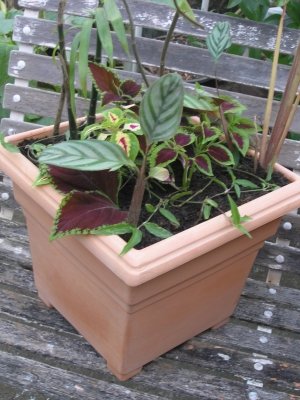
Liquid terracotta dries quickly, needing only about ½ an hour between coats. Normally only two coats are needed, so the second can be brushed smooth or applied with a sponge for a more textured finish. There are a number of sealants available but they cost around twice the price of the terracotta & with pots they are not really necessary. At this stage, I plan to watch how the finish on my outdoor pots handles the elements. If it does start to fade, hose off or run, I will seal it with a clear maritime varnish. These come in aerosol cans & are a lot cheaper than the official sealants.
We are going one step further by making a whitewash, as described on the Mega Treat site. That is, two parts white liquid terracotta, to one part water; mixed well & applied with a sponge. It is important to ensure the pot is dry before using the whitewash & to avoid applying it too heavily. Just wet the sponge lightly & wipe the pot to pale the terracotta. This gives it an aged look, which will be made more authentic by spreading the whitewash unevenly.
As mentioned, liquid terracotta can also be used on a range of interior & exterior building surfaces. A terracotta wall or floor surface would make a great feature in many outdoor settings & create a good starting point for a theme. Building on this look is as easy as applying the terracotta to pots & other garden features. On the Mega Treat site, there is even an example of a house painted entirely with liquid terracotta.
All in all, I am quite impressed with liquid terracotta & would recommend it. From a single litre jar, I expect to cover around 15 containers averaging the size of those pictured below. That is, for around AU$50.00, minus the fun I had painting & the plants I found on the bargain table whilst at the hardware store. American readers need only visit local hardware stores as I did, to locate an equivalent product. If you can't see something on the shelves ask someone. They may be able to order it in.
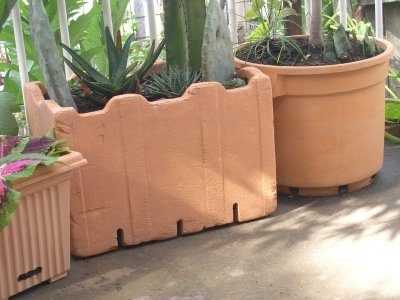
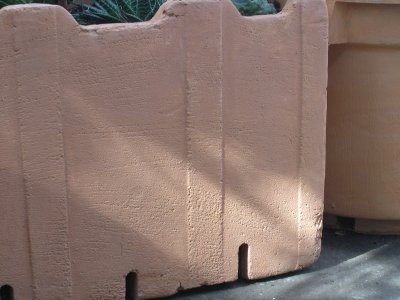
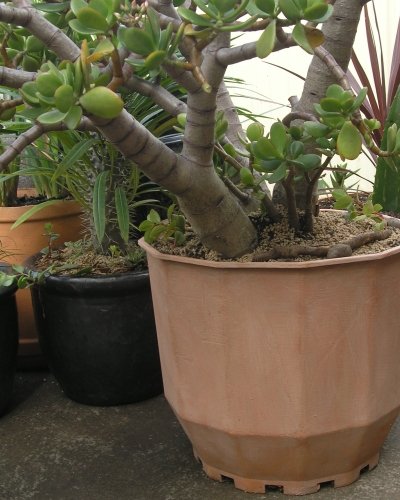
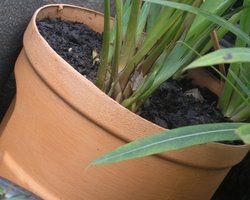
Copyright © www.100flowers.win Botanic Garden All Rights Reserved